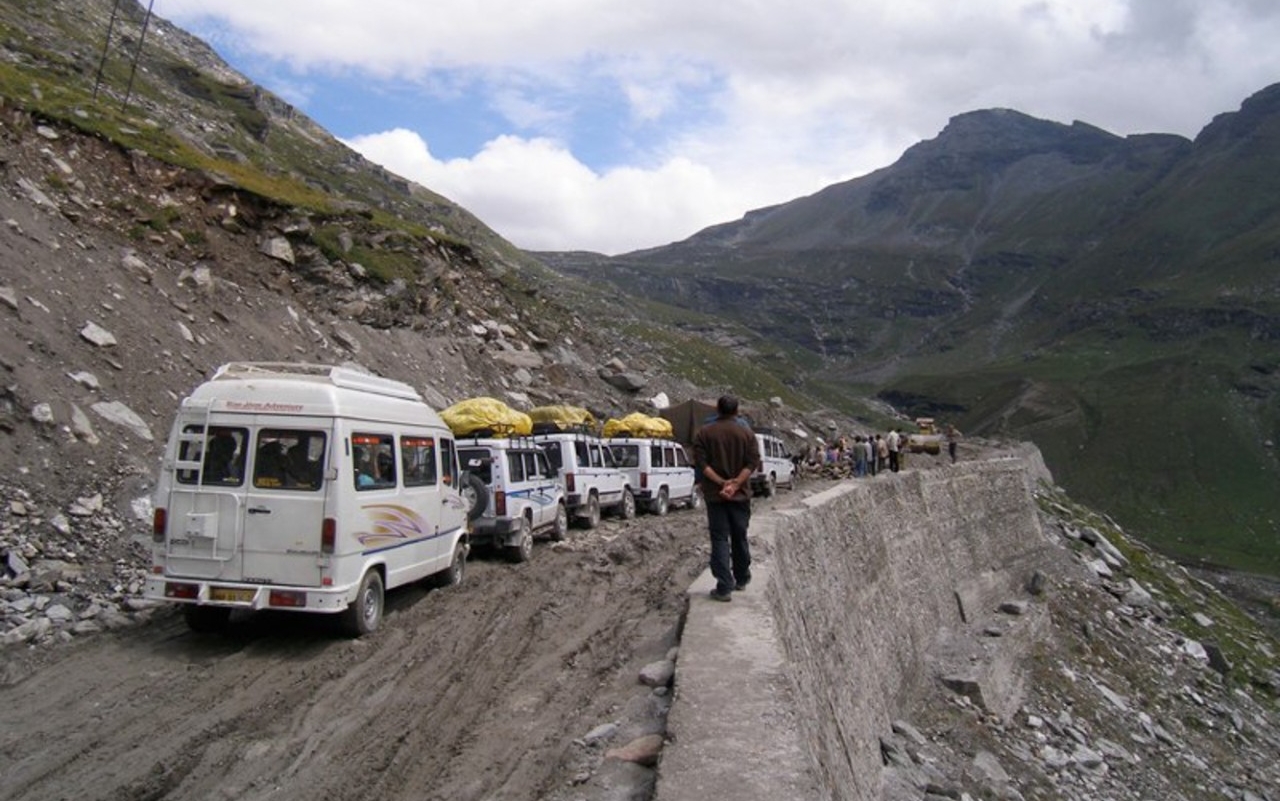UC researchers found pollution from traffic along the Manali-Leh Highway in India's Himalaya Mountains. (Photo by Brooke Crowley.)
Commuting at the top of the world
UC researchers find evidence of truck pollution in one of the most remote corners of the planet: the Himalayas.
By Michael Miller
513-556-6757
May 1, 2017
Smog from cars and trucks is an expected health hazard in big cities, but researchers from the University of Cincinnati found pollution from truck exhaust on one of the most remote mountain roads in the world.
Brooke Crowley, an assistant professor of geology and anthropology, and UC graduate student Rajarshi Dasgupta examined soil pollution along India’s Manali-Leh Highway in the Himalaya Mountains.
This tortuous 300-mile route, much of it gravel or dirt, winds its way over one of the highest navigable mountain passes in the world at 17,480 feet. That’s 4,000 feet higher in elevation than the top of Wyoming’s Grand Teton.
The road’s very remoteness has made it an international tourist attraction, drawing cyclists and adventurers keen on treading where so few have.
Even here in one of the most distant corners of the planet, a place of desolate valleys and austere beauty, the researchers in UC’s McMicken College of Arts and Sciences found evidence of pollution from diesel exhaust.
“We measured incredibly high amounts of sulfur close to the highway. Some of those values are the highest ever reported in the literature and were likely connected to truck traffic,” Crowley said.
“At first glance, it’s easy to consider the region to be a pretty pristine place. But there are environmental impacts from humans.”
‒ UC assistant professor Brooke Crowley
The results were published in the journal Archives of Environmental Contamination and Toxicology. The research was funded through grants by the UC Research Council, Sigma Xi and the Oak Ridge Associated Universities.
For the study, Dasgupta took soil samples at four places along the highway and at six prescribed distances, starting with samples literally on the dirt road and extending out 150 meters. Soil samples were collected at 3, 9 and 15 centimeters in depth.
Dasgupta said villagers in this area burn wood and cow dung for cooking and heating their homes. The resulting smoke often contains polycyclic aromatic hydrocarbons, a known carcinogen.
They tested the soil for these hydrocarbons along with sulfur, total organic compound and 10 types of heavy metal. This wide net was necessary to capture the myriad potential pollutants caused by truck traffic, Dasgupta said.
The study found low levels of heavy metals and no relationship between their concentrations and distance from the highway. But they found high concentrations of sulfur, a major pollutant in the exhaust of diesel-powered engines.
“This area provided us with a rare opportunity to examine the effects of multiple contaminants in a remote, diesel-dominated, mountainous environment,” Dasgupta said.

UC assistant professor of geology Brooke Crowley found pollution from heavy trucks in one of the most remote places on Earth. (Photo by Andrew Higley/UC Creative Services.)
Comparative studies have found that India’s diesel contains an especially high sulfur content, the UC researchers said. Sulfur dioxide in the atmosphere contributes to acid rain.
“At first glance, it’s easy to consider the region to be a pretty pristine place. But there are environmental impacts from humans,” Crowley said.
Last year India ratified the Paris Agreement on climate change. The world’s second-largest nation by population produces nearly 5 percent of the world’s greenhouse gases. The agreement calls for participating countries to develop a plan to address temperature rise.
India has a goal of producing 40 percent of its electricity with renewable energy by 2030.
Diesel fuel is popular in India because it historically cost drivers less there than regular unleaded. Most of the buses and heavy trucks that traverse the Manali-Leh Highway burn diesel fuel. Completed in the 1970s, the road between Manali and Leh sees about 50,000 vehicles per year, mostly during the summer when the mountain passes are free of snow, according to government traffic counts. Himalaya means “abode of snow” in Sanskrit.
UC researchers found the highest sulfur contents at the base of the narrow ridges that are most prone to rockslides. Trucks sometimes must wait to use a single lane while construction crews make repairs.
“The road is terrible, and it’s almost always under construction. There can be lines of traffic idling waiting to go over the passes,” she said. “Our results suggest that a fair amount of emissions accumulate in the soil.”
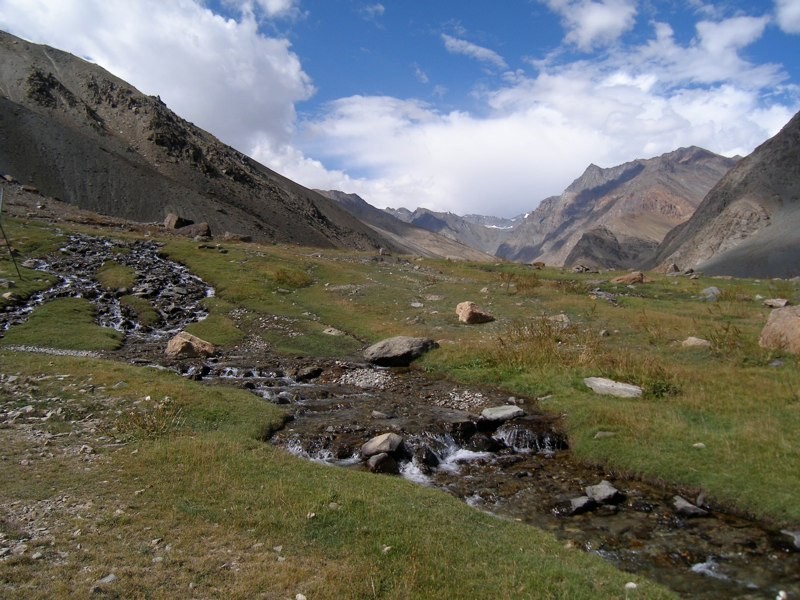
The Manali-Leh Highway spans the beautiful Himalayas. UC researchers found evidence of traffic pollution even here. (Photo by Brooke Crowley)
UC professor Lewis Owen, the geology department head, said Crowley’s findings are in keeping with other studies on pollution impacts in the region.
“It’s not surprising at all if you’ve ever been to the Himalayas and seen all the diesel trucks that use the highways,” he said.
Air pollution from Asian cities also ends up contaminating the remote region’s mountains and streams, he said.
“There is no pristine environment left. You see black snow deposited on glaciers and snowfields in Tibet,” Owen said. “This study is adding to our data set about how we’re degrading the planet. Humans are the biggest geologic agents now. Some researchers are calling this geologic age ‘the Anthropocene’ after the human influence.”
This study and others like it show the cumulative effect of fossil fuels on the environment, he said.
“The biggest challenge is for the research to be disseminated to people who can do something about it,” he said.
“There is no doubt that increasing economic development will put more stress on environments all over the world, remote or not."
‒ Rajarshi Dasgupta, UC graduate student
Dasgupta said countries can monitor pollution and its resulting health effects and invest in more renewable energy and other eco-friendly alternatives to reduce their carbon footprint.
“There is no doubt that increasing economic development will put more stress on environments all over the world, remote or not,” Dasgupta said.
UC’s Crowley has published studies on topics as diverse as plant defenses against species of now-extinct lemurs and the long-distance treks of extinct mammoths.
The study marked Crowley’s second visit to the Himalaya region. But Crowley’s scientific interests have taken her around the world. She has made four trips to Madagascar to study lemurs and reconstruct the causes and consequences of extinctions on the island. She and her students have examined the effects of sea spray on vegetation in Trinidad and looked at ways the first humans in the Canary Islands changed its ecology.
“I’m a paleoecologist. I’m interested in human-animal interactions. I haven’t conducted pollution research previously, and this study with Rajarshi has stretched me in a new direction,” she said.
Dasgupta said the study proved to be a learning experience for him as well.
“This study was the first of its kind for me, too,” Dasgupta said. “I am a geomorphologist. I study the evolution of the landforms around us. However, as a geographer, I have always been interested in the interactions of humans with the natural environment – the central theme of all geographic research. This study fits that theme perfectly.”

UC graduate student Rajarshi Dasgupta (Photo by Banhisikha Bhadury)
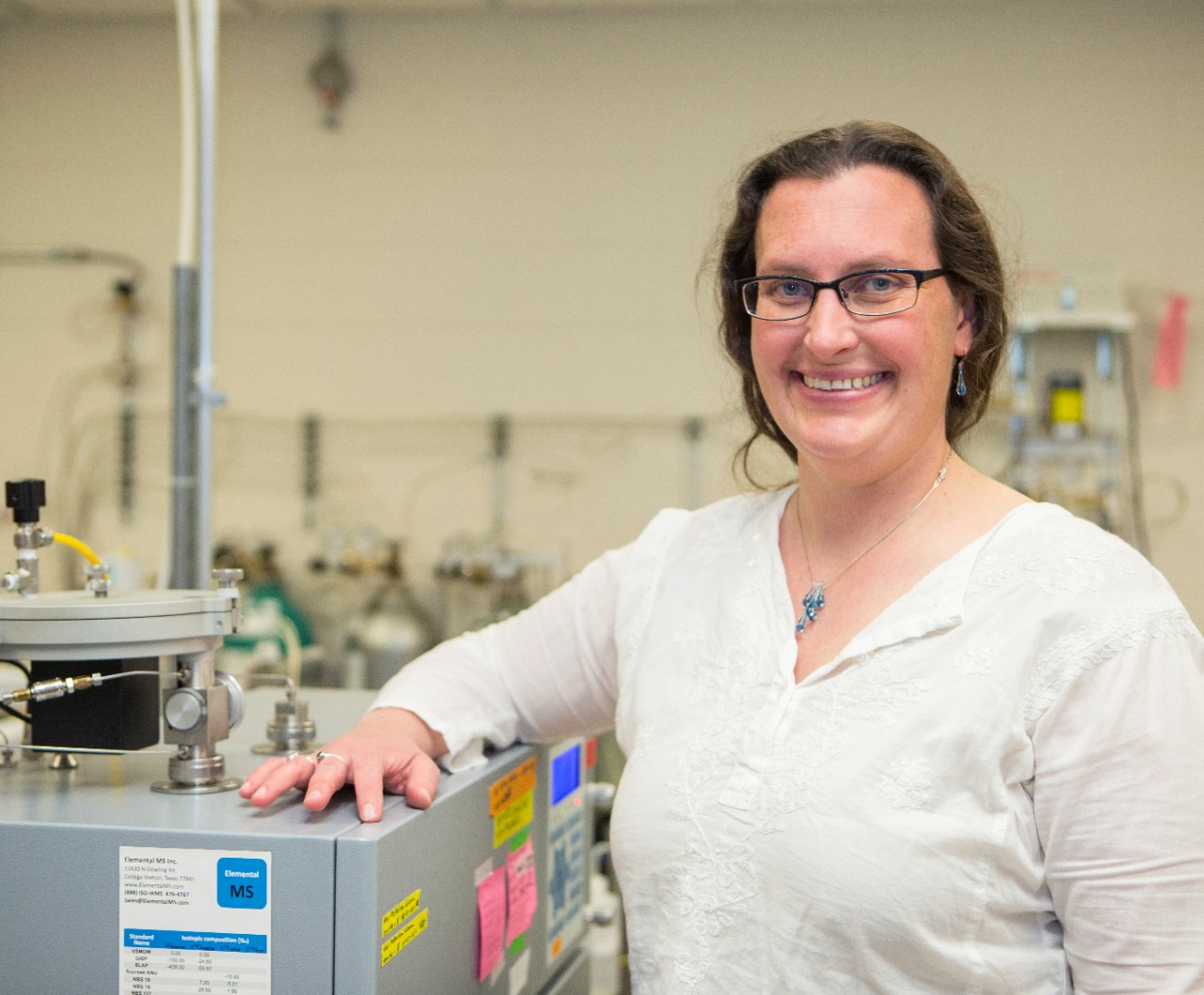
UC assistant professor Brooke Crowley has studied a variety of interests, from mammoths to plant ecology. (Photo by Andrew Higley/UC Creative Services)
In the Himalayas, the researchers found native wildlife such as ibex, herds of wild asses called kiang and condors, one of the largest birds on the planet. Adding to the bucolic scene, many of the villagers who live in the foothills tend goats.
“It’s a beautiful landscape. The scale is hard to comprehend when you’re driving on a plain at 15,000 feet above sea level. That’s really high. It takes a while to acclimatize to the elevation,” Crowley said.
The night skies were full of stars in that sparsely inhabited part of India, with little moisture in the atmosphere to obscure the view. The arid mountains have little vegetation and lots of exposed strata of rock.
“It’s a geologist’s dream. UC professors in geology have been conducting research and teaching classes in this region for many years,” she said. “I am so grateful I was able to join them in the field.”
But being in the field can be challenging. The researchers had to hire an experienced driver to take them over the mountains. They used a filtration system to provide clean drinking water. In some of the low-lying areas, they had to help push their truck out of the mud.
“We’ve gotten a flat tire both times we’ve gone to India. You need nerves of steel to deal with the blind curves,” she said.
Crowley said places on the extreme edges of habitability such as the Himalayas could be the first to feel the effects of dramatic climate change. These mountain ranges provide water and nutrients for rivers in India.
“These are places that might have perennial glaciers that are important sources of water. If the glaciers disappear, that has major implications for people who rely on that water,” she said.
The samples collected for this study provide baseline data if researchers decide to revisit the topic of roadside pollution in 10 or 20 years, she said.
And given her track record of travel for UC, Crowley might be the one leading that expedition, too.
“One of the joys of being a professor is you have some freedom in the kinds of research questions you can explore,” she said. “I have appreciated that opportunity here at UC.”
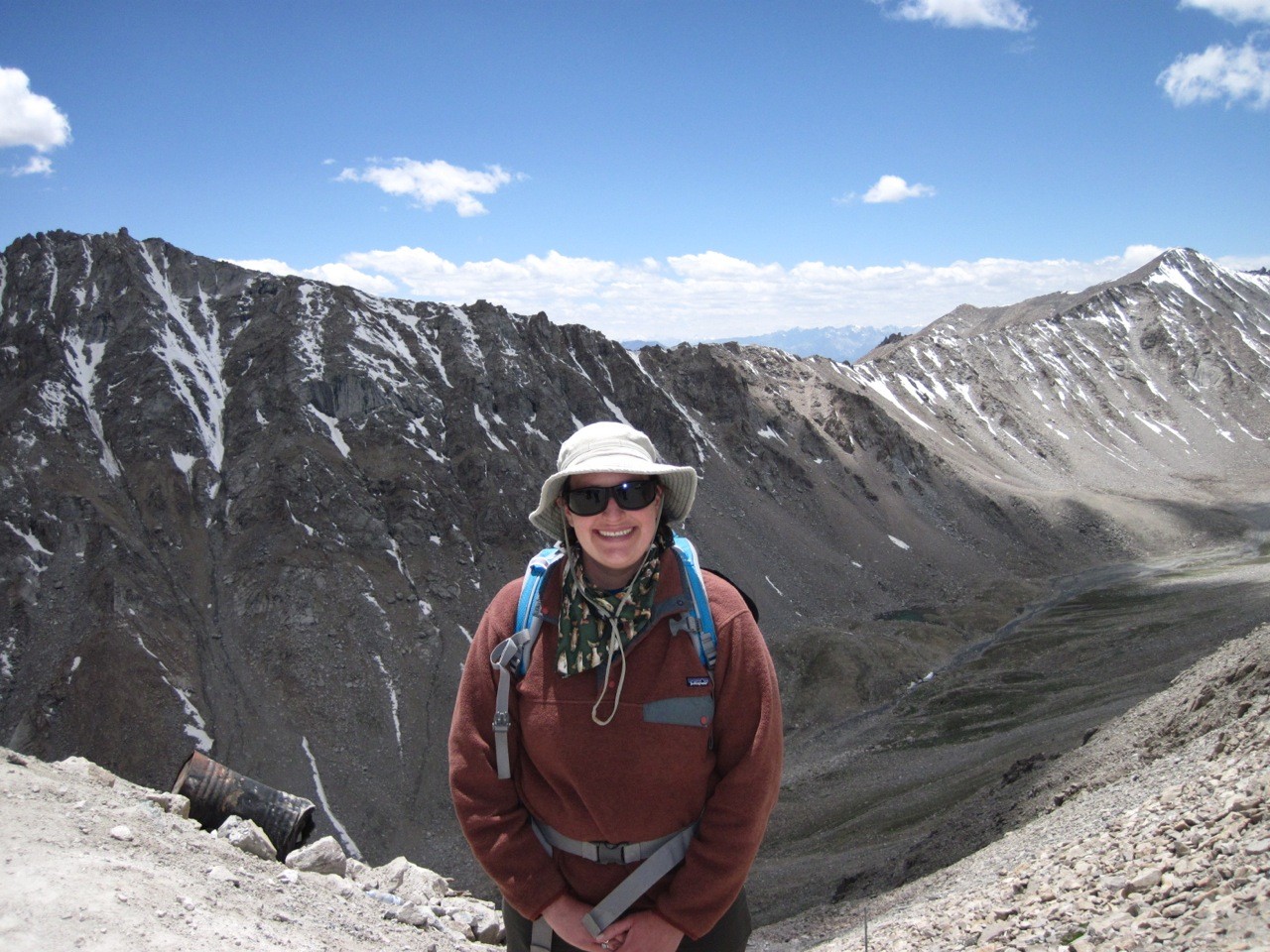
UC assistant professor Brooke Crowley has traveled the world studying geology and anthropology. (Photos by Brooke Crowley.)
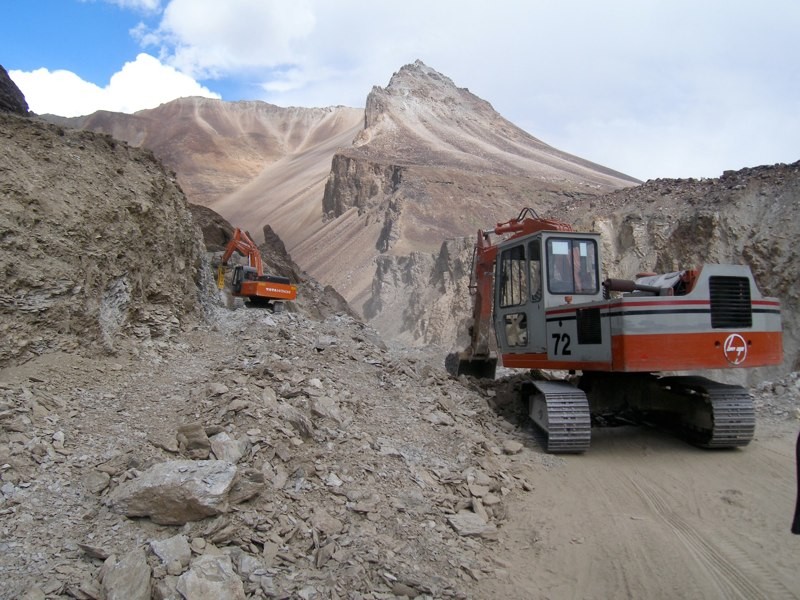
Construction crews make repairs to the Manali-Leh Highway.
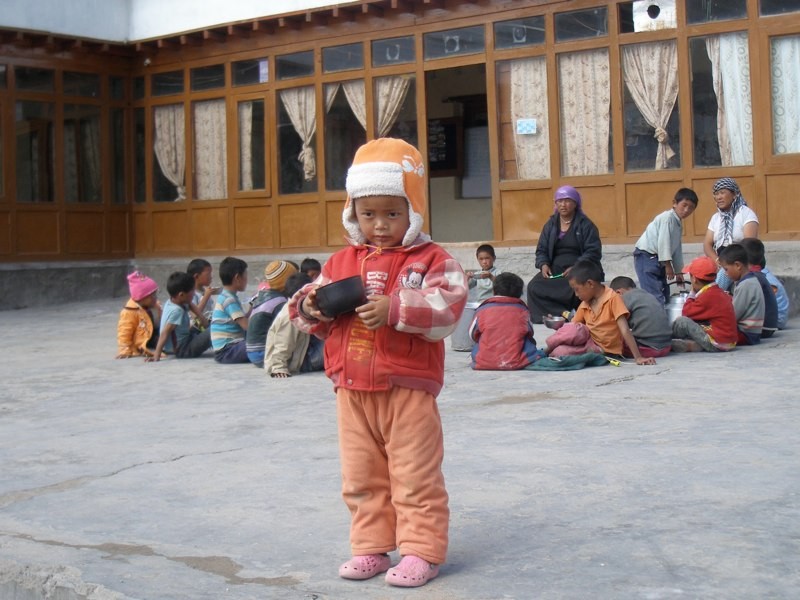
An Indian child breaks away from classmates outside a school in the remote mountains of the Himalaya.
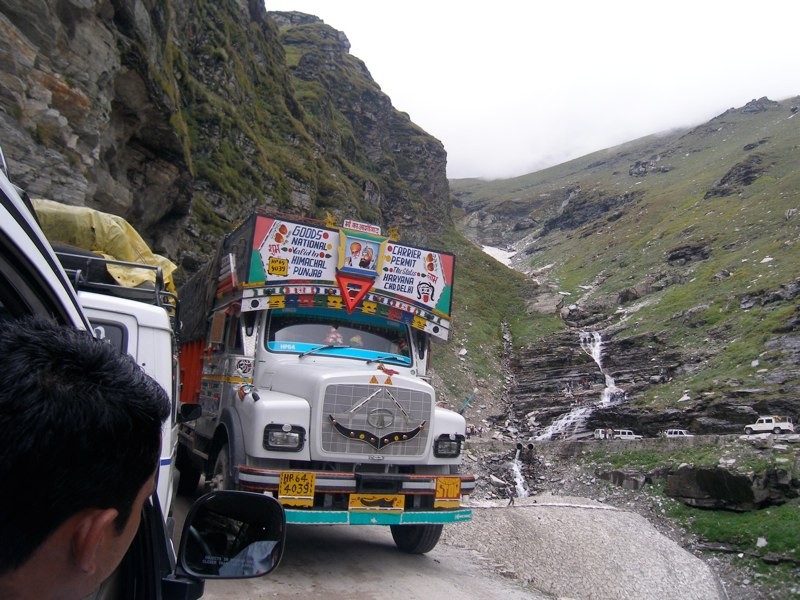
Trucks carefully pass on the narrow Manali-Leh Highway.
Explore the world
Do you have an adventurous spirit? At UC, geology students have a chance to conduct hands-on research. Apply to the Department of Geology or explore other programs on the undergraduate or graduate level.

